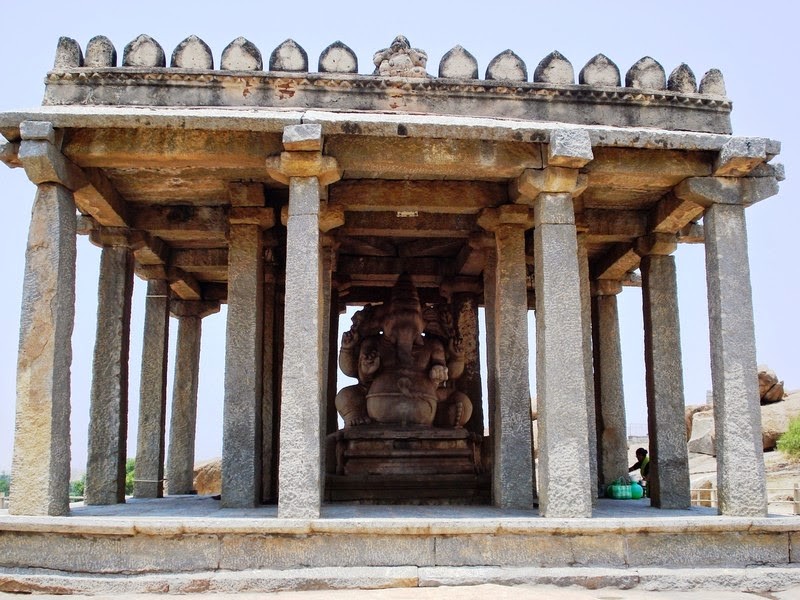Ganesha Navaratri aka Vinayaka Chaviti is one of the most important festivals in entire country. After the festival took a public colour in 1880s, it became all the more interesting event for family and everyone started enjoy participating the nine days festivities. Even as all the cities are having their own festival events, for those who would love to go on a spiritual tour of popular Ganesha temples in south India, here is must visit important temples for you.
Kanipakam Vinayaka, Chittoor
Kanipakam is a small village on the bank of Bahuda River Located around 75 kilometres away from Tirupati in Chittoor, the Kanipakam Vinayaka Temple (also known as Sri Varasidhi Vinayaka Swamy Temple) is known for its glorious history.
The temple was built by the Chola King Kulothings Chola I in the 11th Century to resolve a dispute between communities.

Legend
“Kani” means wetland and “Pakam” means flow of water into wetland. According to the legend of the temple there were three brothers and each one had a handicap, Dumb, Deaf and Blind. They were earning out their livelihood by cultivating a small piece of land.
In olden days water was drawn from the well by way of ‘Piccota System’. As one of them used to irrigate the field through the channels, the other two used to ply on the Piccota. On one such operation they found that the water in the well got dried up and they could no longer continue their job. One of them got into the well and started digging it up. He was taken aback to see the iron implement hitting a stone like formation.
Later, he was shocked to see blood oozing out from it. Within in a few seconds the entire water in the well, turned blood red in colour. Thus, startled by this divine sight, all the three became normal getting rid of their deformities. As soon as the villagers came to know about this miracle, they thronged to the well and tried to deepen the well further. But their attempt proved futile because the ‘swayambhu’ idol (the self-manifested) of Lord Vinayaka emerged from the swirling waters.
Ultimately they offered many number of coconuts with all prayers- modesty kneeling before the new idol afford “Mangalaharathi”and tendered number of coconuts. The coconuts water flowed into the channel to a distance of more than one and a quarter acres. The indication of this led to the modification in the usage of the Tamil word “KANIPARAKAM” and later pronounced as KANIPAKAM. Even today the idol is in the original well and the springs of the well are perennial and the eternal. During the rainy season, the holy water from the well overflows even today.
Another striking and strange feature of the idol is that it is still growing in size. At present, we see the knees and the abdomen of the idol, the ‘Kavacham’ (Armour) to the Lord by devotee, fifty years ago doesn’t fir the idol today. The holy water from the well is offered to the devotees as theertham.
Today, people from across India visit this temple during Ganesh Chaturthi to celebrate Brahmotsavam, the main festival of the the Lord.
Dodda Ganpathi Temple, Bangalore

Located on the Bull Temple Road in Basavanagudi, South Banglore Dodda Basavana Gudi (the Nandhi Temple), is inside a park called Bugle Rock. Dodda Ganapathi Temple is home to an 18 feet tall Ganesha idol that is 16 feet in width.
The temple was built in 1537 by Kempe Gowda under the Vijayanagara empire in the Vijayanagara architectural style, he also founded the city of Bangalore. The temple is named after the large granite Nandi monolith placed on a plinth in the temple shrine (garbhagriha) which has become blackened from years of being rubbed with charcoal and oil. The temple is a small one, consisting only of the shrine fronted by a porch in the Vijayanagara style. The current tower (vimana) over the shrine was constructed in the early 20th century and is adorned with Saivite figures and motifs.
Madhur Maha Ganapathi Temple, Kottarakkara
Kottarakkara Sree Mahaganapathy Kshethram is a pilgrim centre in South India. It is centuries old and the most important Maha Ganapathi Temple in Kerala. The Ganapati temple is located in Kottarakkara which is 25 km from Kollam. Though the main temple of Lord shiva, Lord Ganesha is more popular in this Kshetram.
It is known for its stunning architecture and glorious history. The pond around the temple is believed to have medicinal properties that can heal even rare illnesses.

Legend
Madhur temple was originally Madarantheswara (Shiva) Temple and as the lore goes, an old women called Madaru from local Tulu Moger Community discovered an “Udbhava Murthy” (a statue that was not made by a human) of shiva linga. Initially, the Ganapathy picture was drawn by a boy, on the southern wall of the Garbhagriha(sanctum sanctorum) while playing. Day by day it became big and fat; so that the boy called Ganapathi as “boddajja” or “bodda ganesha”. The legend of Kumble seme says Tipu Sultan wanted to demolish the temple like Adooru Mahalingeswara temple during his invasion of Coorg, Tulunadu, and Malabar. But after drinking water from the well of the temple, he changed his mind on attacking and demolishing the Garbhagudi and marched towards Malabar. But to satisfy his soldiers and Islamic scholars he made a cut with his sword symbolizing the attack. The mark is still visible on the building that is built around the temple well. The temple architecture is of 3-tiered gajaprishta type resembling the back of an elephant. One can also find beautiful wooden carvings depicting scenes from the Ramayana.The vast spacious gopurams give good ambiance for the devotees to relax and enjoy the Ganapathi`s presence.
Karpaka Vinayakar, Thiruppatthur
Pillaiyar patti Pillaiyar temple is an ancient rock-cut cave shrine dedicated to Ganesha, is located in Thiruppatthur, Tamil Nadu. Believed to be around 1600 years old, has the rock cut images of Siva and other gods as well as several shrines. The Agama texts found on stones in the temple help date the temple between the years 1091 and 1238. The temple was built under patronisation of Pandyas.

Ganehsa’s trunk is curved to the right side which is unique feature of Lord here. Lord Karpaga Vinayagar is seated facing northern side. There are deities in this temple such as goddess Karthiyayini (who arrange marriages), Nagalingam (who gifts offspring), Pasupatheeswarar (who showers all wealth).
The temple welcomes hundreds of devotees every year during Ganesh Chaturthi. Ganesh Chathurthi is this temple’s most important festival. It is 10 days long. Kappaukkattutual and hoisting temple flag begin before 9 days. On the 9th day car festival and much celebrated decoration of sandal covering ( Santha-na-kkappu) to Pillaiyar takes place.
Shree Vinayaka Devaru Temple, Idagunji
The Shree Vinayaka Devaru located on the West Coast of India in the Idagunji town in Uttara Kannada district. Idagunji Devasthana is an ancient temple with a history of more than 1500 years.
The central icon of the Idagunji Temple dates back to 4-5th century AD. The image of Ganesha is in dvibhuja style, has two arms and is standing on a stone slab. With a lotus bud on his right hand and he holds a modak sweet in other hand. He wears a garland across the chest in the style of a yagnopavita (sacred thread). Ganesha is adorned with a necklace of small bells. A rat, the vahana or vehicle of Ganesha, always depicted alongside Ganesha.

Legend
At the end of ‘Dwapara Yuga’ great saints were praying to the Sutha-Pouranika at Badarikashrama to eliminate the on coming doshas of ‘Kaliyuga’. The divine saint, Valakhilya initiated narrating the significance of Kunjavana.
They started encountering many obstacles, the holy saint was agitated by these obstacles Prayed to Lord Krishna. Narada the noble saint approached Valakhilya, who sought solution to deal with the obstacles. Narada advised him to worship God Vigneshwara (the remover of obstacles) before starting the penance again.
Valakhilya requested Narada to show him an appropriate place to worship the deity. Narada along with Valakhilya and other saints wandered westward and came across the Sharavati river which gracefully caressed and consolidated with the ocean. Narada chalked out an exact place located a few miles away to the left of Sharavati. The place was named as Kunjaranya and decided that this would be the best place for them to have penitential activities.
Narada explained the significance of the place saying that earlier Te Holy Trinity used to perorm their penance here. Narada approached Brahma, Vishnu and Maheshwara to attend the “Puja” at Kunjaranya offered by the saints. He also took the liberty of requesting Parvathi to send her son, Ganapathi to the saints for the removal of obstacles.
Immensely pleased by the devotion rendered on him by the saints, Ganapathi expressed his desire to grant the wishes of his devotees. He also implied the Gods to leave behind a part of their omniscient power in the various lakes encompassed there. lake was bestowed to provide water for bathing at Ganapathi’s request. It was named as “Ganeshtith”.So according to this purana , Lord Ganapathi stayed in the place Kunjaranya which is now renowned as Idagunji.
Must Read Significance of Ganesh Chaturthi : Sri Sri Ravishankar
Must Read Exclusive : Viseo of Saint Ram Rahim before Court Appearance









